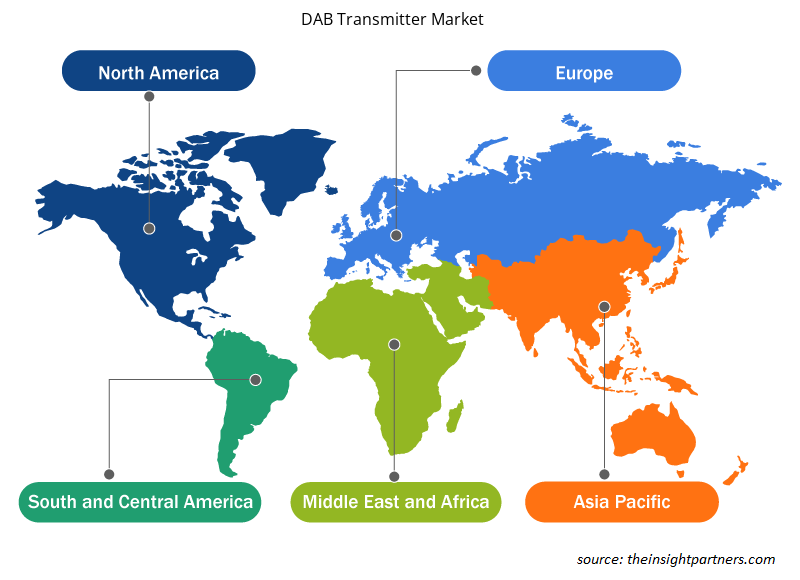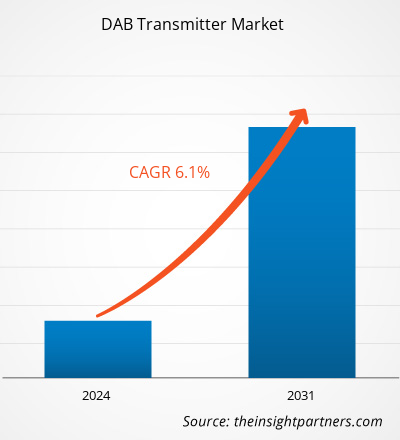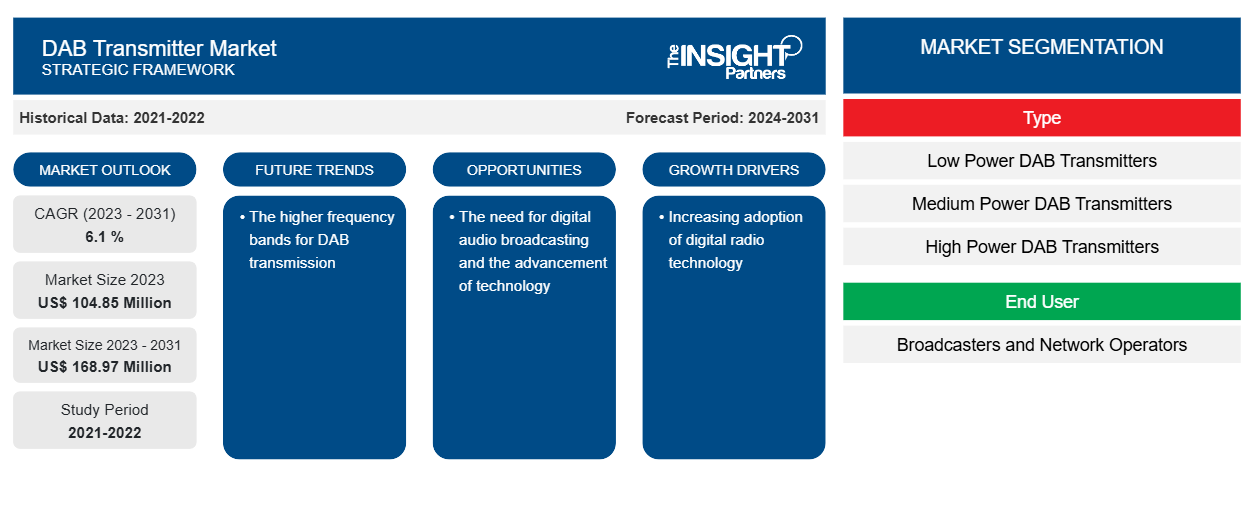DAB 发射机市场规模预计将从 2023 年的 1.0485 亿美元增至 2031 年的 1.6897 亿美元。预计 2023-2031 年期间市场复合年增长率将达到 6.1%。DAB 传输的较高频段可能仍是市场的主要趋势。CAGR of 6.1 % during 2023–2031. The higher frequency bands for DAB transmission are likely to remain a key trend in the market.
DAB 发射机市场分析
全球 DAB 发射器市场主要受到无人机在勘测、制图和监控等各种应用中日益普及的推动。此外,越来越多的初创企业正在推动全球 DAB 发射器市场的扩张。此外,使用 DAB 收音机,用户可以接收所有广播电台,用户不再依赖于接收。因此,预计在预测期内,对数字音频广播的需求和技术进步将为市场增长创造丰厚的机会。forecasted period.
DAB 发射机市场概况
数字音频广播 (DAB) 技术使广播公司能够向甚高频 (VHF) 频段的移动和固定接收器传输高质量的数字音频和数据服务,同时允许多个广播电台使用单个发射器在同一频率上广播,从而分担传输成本。DAB 是 DAB 发射器的升级版,它提供更好的音频质量、更高效的频谱利用率(用于附加服务)和更强大的接收能力。
定制此报告以满足您的需求
您可以免费定制任何报告,包括本报告的部分内容、国家级分析、Excel 数据包,以及为初创企业和大学提供优惠和折扣
-
获取此报告的关键市场趋势。这个免费样品将包括数据分析,从市场趋势到估计和预测。
DAB 发射机市场驱动因素和机遇
数字广播技术的采用日益广泛
DAB 使用的频率比 FM 高,因此可能需要使用更多发射器来实现与单个 FM 发射器相同的覆盖范围。各种公司通常从广播公司传输 DAB,然后广播公司将容量出售给多个广播电台。DAB 调谐器还可以用作蓝牙扬声器和闹钟收音机。使用 DAB 收音机,用户可以接收所有广播电台,并且用户不再依赖于接收。一些现代广播电台也在转向 DAB。因此他们不能再通过 FM 收音机接收它们。
数字音频广播的需求和技术的进步
由于 DAB 系统可以提供一系列数据服务,包括详细的每日广播时间表、视觉幻灯片和重要的交通更新(包括有关交通事件、停车、公共交通和电动汽车的信息),因此对高质量数字音频的需求正在增长。此外,对先进技术的需求也在增加。DAB 发射器的使用采用了各种技术,例如结合最新的 RF 组合器技术、不平衡假负载以及 RF 模块、驱动器和逻辑控制系统之间的智能互通接口。因此,预计在预测期内,对数字音频广播的需求和技术进步将为市场增长创造丰厚的机会。forecasted period.
DAB 发射机市场报告细分分析
有助于得出 DAB 发射机市场分析的关键部分是类型和最终用户。
- 根据类型,DAB 发射器市场分为低功率 DAB 发射器、中功率 DAB 发射器和高功率 DAB 发射器。迷你四路发射器在 2023 年占据了更大的市场份额。
- 根据最终用户,市场分为广播公司和网络运营商。
DAB 发射机市场份额按地区分析
DAB发射机市场报告的地理范围主要分为五个区域:北美、亚太、欧洲、中东和非洲、南美和中美。
北美在 DAB 发射器市场占据主导地位。数字音频广告使北美广告商能够访问整个地区的数字音频广告渠道。美国和加拿大的公司可以获得全国性的广告覆盖,并可以通过播客利用其原生广告格式。这些投资和资金预计将帮助 SAB 发射器提供商扩展业务并为各个行业的最终用户提供解决方案。对无人机日益增长的需求推动了北美的数字音频发展,这可能会使该地区的 DAB 发射器市场受益。SAB transmitter providers expand their businesses and provide solutions to end users from various sectors. The growing demand for drones propels digital audio in North America, which is likely to benefit the DAB transmitter market in the region.
DAB 发射机市场区域洞察
Insight Partners 的分析师已详尽解释了预测期内影响 DAB 发射机市场的区域趋势和因素。本节还讨论了北美、欧洲、亚太地区、中东和非洲以及南美和中美洲的 DAB 发射机市场细分和地理位置。

- 获取 DAB 发射机市场的区域特定数据
DAB 发射机市场报告范围
| 报告属性 | 细节 |
|---|---|
| 2023 年的市场规模 | 1.0485亿美元 |
| 2031 年市场规模 | 1.6897亿美元 |
| 全球复合年增长率(2023 - 2031) | 6.1% |
| 史料 | 2021-2022 |
| 预测期 | 2024-2031 |
| 涵盖的领域 |
按类型
|
| 覆盖地区和国家 |
北美
|
| 市场领导者和主要公司简介 |
|
DAB 发射机市场参与者密度:了解其对业务动态的影响
DAB 发射器市场正在快速增长,这得益于终端用户需求的不断增长,而这些需求又源于消费者偏好的不断变化、技术进步以及对产品优势的认识不断提高等因素。随着需求的增加,企业正在扩大其产品范围,进行创新以满足消费者的需求,并利用新兴趋势,从而进一步推动市场增长。
市场参与者密度是指在特定市场或行业内运营的企业或公司的分布情况。它表明在给定市场空间中,相对于其规模或总市场价值,有多少竞争对手(市场参与者)存在。
在 DAB 发射机市场运营的主要公司有:
- 电联公司
- 埃利诺斯 SRL
- Eletec 无线电广播设备和发射机
- 艾尔蒂公司
- 盖茨航空
- 公司
免责声明:上面列出的公司没有按照任何特定顺序排列。

- 获取 DAB 发射机市场主要参与者概览
DAB 发射机市场新闻和最新发展
DAB 发射器市场通过收集一手和二手研究后的定性和定量数据进行评估,其中包括重要的公司出版物、协会数据和数据库。DAB 发射器市场的一些发展情况如下:
- DAB+ 数字广播在斯皮什的覆盖范围更广。Towercom 本月推出了另一台新发射机,即位于 Branisko 隧道附近的 Rudnik。此次发射是在获得许可证几天后进行的。根据颁发的许可证,发射机在 5C 频道上分配,垂直极化的最大允许功率为 1 千瓦。这是本月推出的第三台 DAB+ 发射机。(来源:Towercom,新闻稿,2023 年 7 月。)
- Muxnet UK 与当地广播公司和社区团体合作,帮助他们推出小型 DAB 多路复用器,并指出过去两年小型 DAB 部署速度很快,标志着第 50 次多路复用器启动具有里程碑意义。(来源:Muxnet UK,新闻稿,2024 年 3 月)
DAB 发射机市场报告覆盖范围和交付成果
“DAB 发射机市场规模和预测(2021-2031)”报告对以下领域进行了详细的市场分析:
- 范围涵盖的所有主要细分市场的全球、区域和国家层面的 DAB 发射机市场规模和预测
- DAB 发射机市场趋势以及市场动态,如驱动因素、限制因素和关键机遇
- 详细的 PEST/波特五力分析和 SWOT 分析
- DAB 发射机市场分析涵盖主要市场趋势、全球和区域框架、主要参与者、法规和最新市场发展
- 行业格局和竞争分析,涵盖市场集中度、热图分析、知名参与者以及 DAB 发射机市场的最新发展
- 详细的公司简介
- 历史分析(2 年)、基准年、预测(7 年)及复合年增长率
- PEST和SWOT分析
- 市场规模、价值/数量 - 全球、区域、国家
- 行业和竞争格局
- Excel 数据集
近期报告
客户评价
购买理由
- 明智的决策
- 了解市场动态
- 竞争分析
- 客户洞察
- 市场预测
- 风险规避
- 战略规划
- 投资论证
- 识别新兴市场
- 优化营销策略
- 提升运营效率
- 顺应监管趋势























 获取免费样品 - DAB发射机市场
获取免费样品 - DAB发射机市场